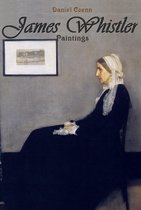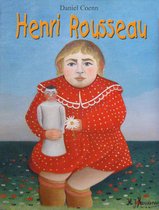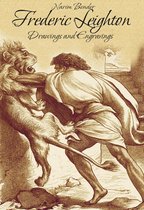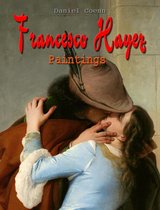My Pocket Gallery - Frederic Leighton Ebook Tooltip Ebooks kunnen worden gelezen op uw computer en op daarvoor geschikte e-readers. Paintings
Afbeeldingen
Sla de afbeeldingen overArtikel vergelijken
- Engels
- E-book
- 1230000148887
- 04 juli 2013
- Epub zonder kopieerbeveiliging (DRM)
Samenvatting
Lord Frederic Leighton was one of the most famous British artists of the nineteenth century. He preferred to paint subject matter that was connected to ancient Greek and Roman mythology and intended for his paintings to be visually beautiful. Leighton's paintings have a reputation for bright colors and firmly drawn figures. Leighton's contemporaries included the French Impressionist painters and he would have seen the work of Monet, Renoir and others in both Paris and London. Leighton said of the Impressionists that 'Impressionism is a reaction from the old conventionalism, but an impressionist must not forget that it is the deep-sinking and not the fugitive impressions which are the best'. Leighton's role at the Royal Academy included the education of younger artists. His great ability for this is summed up in the words of one of his pupils; the sculptor Hamo Thornycroft wrote, 'he was the most energetic and took the greatest pains to help the students. He was, moreover, an inspiring master'.
Lord Frederic Leighton was one of the most famous British artists of the nineteenth century. He preferred to paint subject matter that was connected to ancient Greek and Roman mythology and intended for his paintings to be visually beautiful. Leighton's paintings have a reputation for bright colors and firmly drawn figures. Leighton's contemporaries included the French Impressionist painters and he would have seen the work of Monet, Renoir and others in both Paris and London. Leighton said of the Impressionists that 'Impressionism is a reaction from the old conventionalism, but an impressionist must not forget that it is the deep-sinking and not the fugitive impressions which are the best'. Leighton's role at the Royal Academy included the education of younger artists. His great ability for this is summed up in the words of one of his pupils; the sculptor Hamo Thornycroft wrote, 'he was the most energetic and took the greatest pains to help the students. He was, moreover, an inspiring master'.
Lord Frederic Leighton was one of the most famous British artists of the nineteenth century. He preferred to paint subject matter that was connected to ancient Greek and Roman mythology and intended for his paintings to be visually beautiful. Leighton's paintings have a reputation for bright colors and firmly drawn figures. Leighton's contemporaries included the French Impressionist painters and he would have seen the work of Monet, Renoir and others in both Paris and London. Leighton said of the Impressionists that 'Impressionism is a reaction from the old conventionalism, but an impressionist must not forget that it is the deep-sinking and not the fugitive impressions which are the best'. Leighton's role at the Royal Academy included the education of younger artists. His great ability for this is summed up in the words of one of his pupils; the sculptor Hamo Thornycroft wrote, 'he was the most energetic and took the greatest pains to help the students. He was, moreover, an inspiring master'.
Lord Frederic Leighton was one of the most famous British artists of the nineteenth century. He preferred to paint subject matter that was connected to ancient Greek and Roman mythology and intended for his paintings to be visually beautiful. Leighton's paintings have a reputation for bright colors and firmly drawn figures. Leighton's contemporaries included the French Impressionist painters and he would have seen the work of Monet, Renoir and others in both Paris and London. Leighton said of the Impressionists that 'Impressionism is a reaction from the old conventionalism, but an impressionist must not forget that it is the deep-sinking and not the fugitive impressions which are the best'. Leighton's role at the Royal Academy included the education of younger artists. His great ability for this is summed up in the words of one of his pupils; the sculptor Hamo Thornycroft wrote, 'he was the most energetic and took the greatest pains to help the students. He was, moreover, an inspiring master'.
Lord Frederic Leighton was one of the most famous British artists of the nineteenth century. He preferred to paint subject matter that was connected to ancient Greek and Roman mythology and intended for his paintings to be visually beautiful. Leighton's paintings have a reputation for bright colors and firmly drawn figures. Leighton's contemporaries included the French Impressionist painters and he would have seen the work of Monet, Renoir and others in both Paris and London. Leighton said of the Impressionists that 'Impressionism is a reaction from the old conventionalism, but an impressionist must not forget that it is the deep-sinking and not the fugitive impressions which are the best'. Leighton's role at the Royal Academy included the education of younger artists. His great ability for this is summed up in the words of one of his pupils; the sculptor Hamo Thornycroft wrote, 'he was the most energetic and took the greatest pains to help the students. He was, moreover, an inspiring master'.
Lord Frederic Leighton was one of the most famous British artists of the nineteenth century. He preferred to paint subject matter that was connected to ancient Greek and Roman mythology and intended for his paintings to be visually beautiful. Leighton's paintings have a reputation for bright colors and firmly drawn figures. Leighton's contemporaries included the French Impressionist painters and he would have seen the work of Monet, Renoir and others in both Paris and London. Leighton said of the Impressionists that 'Impressionism is a reaction from the old conventionalism, but an impressionist must not forget that it is the deep-sinking and not the fugitive impressions which are the best'. Leighton's role at the Royal Academy included the education of younger artists. His great ability for this is summed up in the words of one of his pupils; the sculptor Hamo Thornycroft wrote, 'he was the most energetic and took the greatest pains to help the students. He was, moreover, an inspiring master'.
Lord Frederic Leighton was one of the most famous British artists of the nineteenth century. He preferred to paint subject matter that was connected to ancient Greek and Roman mythology and intended for his paintings to be visually beautiful. Leighton's paintings have a reputation for bright colors and firmly drawn figures. Leighton's contemporaries included the French Impressionist painters and he would have seen the work of Monet, Renoir and others in both Paris and London. Leighton said of the Impressionists that 'Impressionism is a reaction from the old conventionalism, but an impressionist must not forget that it is the deep-sinking and not the fugitive impressions which are the best'. Leighton's role at the Royal Academy included the education of younger artists. His great ability for this is summed up in the words of one of his pupils; the sculptor Hamo Thornycroft wrote, 'he was the most energetic and took the greatest pains to help the students. He was, moreover, an inspiring master'.
Lord Frederic Leighton was one of the most famous British artists of the nineteenth century. He preferred to paint subject matter that was connected to ancient Greek and Roman mythology and intended for his paintings to be visually beautiful. Leighton's paintings have a reputation for bright colors and firmly drawn figures. Leighton's contemporaries included the French Impressionist painters and he would have seen the work of Monet, Renoir and others in both Paris and London. Leighton said of the Impressionists that 'Impressionism is a reaction from the old conventionalism, but an impressionist must not forget that it is the deep-sinking and not the fugitive impressions which are the best'. Leighton's role at the Royal Academy included the education of younger artists. His great ability for this is summed up in the words of one of his pupils; the sculptor Hamo Thornycroft wrote, 'he was the most energetic and took the greatest pains to help the students. He was, moreover, an inspiring master'. L
Productspecificaties
Inhoud
- Taal
- en
- Bindwijze
- E-book
- Oorspronkelijke releasedatum
- 04 juli 2013
- Ebook Formaat
- Epub zonder kopieerbeveiliging (DRM)
- Illustraties
- Nee
Betrokkenen
- Hoofdauteur
- Daniel Coenn
- Hoofduitgeverij
- Onbekend
Lees mogelijkheden
- Lees dit ebook op
- Android (smartphone en tablet) | Kobo e-reader | Desktop (Mac en Windows) | iOS (smartphone en tablet) | Windows (smartphone en tablet)
Overige kenmerken
- Studieboek
- Nee
EAN
- EAN
- 1230000148887
Kies gewenste uitvoering
Prijsinformatie en bestellen
De prijs van dit product is 1 euro en 99 cent.- E-book is direct beschikbaar na aankoop
- E-books lezen is voordelig
- Dag en nacht klantenservice
- Veilig betalen
Rapporteer dit artikel
Je wilt melding doen van illegale inhoud over dit artikel:
- Ik wil melding doen als klant
- Ik wil melding doen als autoriteit of trusted flagger
- Ik wil melding doen als partner
- Ik wil melding doen als merkhouder
Geen klant, autoriteit, trusted flagger, merkhouder of partner? Gebruik dan onderstaande link om melding te doen.








